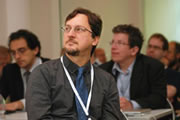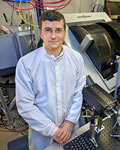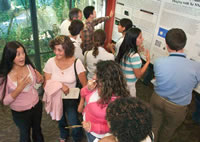


Building 50A is the winner for both June and July in the Director’s Carbon Cycle 2.0 Building Energy Savings Challenge, with a 14.8 and 17.6 percent reduction, respectively, in energy usage in the previous 12 months compared to the FY 2008 baseline. Building 50A had previously placed third in the Energy Savings Challenge in February, the first month of the contest. In second place for June and July is Building 2, which achieved a 6.3 and 7.4 percent savings, respectively. In third place for June were Buildings 84 and 84B and for July was Building 66.
Each month, the Energy Challenge will honor the top three Berkeley Lab buildings with the greatest improvements in energy savings. The building with greatest improvement after six months will be treated to a lunch for the entire building, hosted by Lab Director Paul Alivisatos. More>
 Yuegang Zhang of the Materials Sciences Division led a multi-institutional team of researchers at the Molecular Foundry in developing the first model of signal-to-noise ratios for low-frequency noises in graphene on silica. Their results show noise patterns that run just the opposite of noise patterns in other electronic materials. The model should help in the fabrication of future graphene-based electronic devices with high signal-to-noise ratios. More>
Yuegang Zhang of the Materials Sciences Division led a multi-institutional team of researchers at the Molecular Foundry in developing the first model of signal-to-noise ratios for low-frequency noises in graphene on silica. Their results show noise patterns that run just the opposite of noise patterns in other electronic materials. The model should help in the fabrication of future graphene-based electronic devices with high signal-to-noise ratios. More>
 Earth Sciences Division Director Don DePaolo has announced the appointment of Susan Hubbard as Deputy Division Director for Programs. Hubbard currently leads ESD's Environmental Remediation and Water Resources Program and Sustainable Systems Scientific Focus Area. Her research focuses on methods for shallow subsurface monitoring and using integrated datasets to investigate environmental problems, topics in which she has published widely. Former deputy Ernie Majer is now senior advisor to DePaolo, providing strategic guidance on divisional operations. Majer continues his research on seismic-wave analyses in geothermal and petroleum regions and testing instruments and techniques for locating and assessing geothermal and petroleum sources. More>
Earth Sciences Division Director Don DePaolo has announced the appointment of Susan Hubbard as Deputy Division Director for Programs. Hubbard currently leads ESD's Environmental Remediation and Water Resources Program and Sustainable Systems Scientific Focus Area. Her research focuses on methods for shallow subsurface monitoring and using integrated datasets to investigate environmental problems, topics in which she has published widely. Former deputy Ernie Majer is now senior advisor to DePaolo, providing strategic guidance on divisional operations. Majer continues his research on seismic-wave analyses in geothermal and petroleum regions and testing instruments and techniques for locating and assessing geothermal and petroleum sources. More>
 [Scientific Computing] A new approach is needed to reach a set of common, useful metrics for energy efficiency in high-performance computing (HPC), says John Shalf, head of the Advanced Technologies Group at the National Energy Research Scientific Computing Center (NERSC). Shalf co-organized a Birds-of-a-Feather session at the recent 2010 International Supercomputing Conference in Hamburg, Germany. “We need metrics that provide a better reflection of real-world use of these machines to run codes and applications,” he writes in Scientific Computing, stressing that the energy efficiency of the facility as a whole, including cooling, should not be overlooked. More>
[Scientific Computing] A new approach is needed to reach a set of common, useful metrics for energy efficiency in high-performance computing (HPC), says John Shalf, head of the Advanced Technologies Group at the National Energy Research Scientific Computing Center (NERSC). Shalf co-organized a Birds-of-a-Feather session at the recent 2010 International Supercomputing Conference in Hamburg, Germany. “We need metrics that provide a better reflection of real-world use of these machines to run codes and applications,” he writes in Scientific Computing, stressing that the energy efficiency of the facility as a whole, including cooling, should not be overlooked. More>
 People: Leemans Chairs International Task Force on Future Accelerators
People: Leemans Chairs International Task Force on Future Accelerators Wim Leemans, head of the LOASIS program in the Accelerator and Fusion Research Division, chairs the newly established Joint Task Force on Future Applications of Laser Acceleration, established by two influential international groups, the International Committee for Future Accelerators and the International Committee on Ultra-High Intensity Lasers. At a recent conference at GSI (Center for Heavy Ion Research) in Darmstadt, Germany, kicked off by Leemans and GSI’s technical director Hartmut Eickhoff, 47 experts from China, France, Germany, Japan, Switzerland, and the U.S. met to tackle the challenges of creating laser-based accelerators for future colliders, light sources, and medical applications. More>
 Berkeley Lab’s Center for Science & Engineering Education hosts a poster session tomorrow, Wednesday, Aug. 11, from 3 to 5 p.m. in the Cafeteria and Perseverance Hall, featuring the work of 116 undergraduate students who have spent their summer in the Lab’s mentored internship programs. The internship programs allow students to work with world-class scientists and engineers on projects contributing to the Lab’s cutting edge research. By highlighting the experience of the teachers and students who take part in the programs, the poster session is a rare opportunity to show examples of the Lab’s wide-ranging research. Refreshments will be served.
Berkeley Lab’s Center for Science & Engineering Education hosts a poster session tomorrow, Wednesday, Aug. 11, from 3 to 5 p.m. in the Cafeteria and Perseverance Hall, featuring the work of 116 undergraduate students who have spent their summer in the Lab’s mentored internship programs. The internship programs allow students to work with world-class scientists and engineers on projects contributing to the Lab’s cutting edge research. By highlighting the experience of the teachers and students who take part in the programs, the poster session is a rare opportunity to show examples of the Lab’s wide-ranging research. Refreshments will be served.
 Those who knew Berkeley Lab scientific greats Glenn Seaborg and Al Ghiorso but perhaps never thought of them as the “Ernest Hemingway and Theodore Roosevelt” of the periodic table might be interested in reading The Disappearing Spoon, and Other True Tales of Madness, Love and the History of the World From the Periodic Table of Elements, published by Little, Brown & Company. Author Sam Kean makes the comparison of Seaborg and Ghiorso to hunters Hemingway and Roosevelt on the basis that “they bagged so many elements.” He also credits Nobel laureate Seaborg and his Berkeley Lab colleagues with developing the structure of the periodic table that is most widely used today. For Janet Maslin’s New York Times review of the book go here.
Those who knew Berkeley Lab scientific greats Glenn Seaborg and Al Ghiorso but perhaps never thought of them as the “Ernest Hemingway and Theodore Roosevelt” of the periodic table might be interested in reading The Disappearing Spoon, and Other True Tales of Madness, Love and the History of the World From the Periodic Table of Elements, published by Little, Brown & Company. Author Sam Kean makes the comparison of Seaborg and Ghiorso to hunters Hemingway and Roosevelt on the basis that “they bagged so many elements.” He also credits Nobel laureate Seaborg and his Berkeley Lab colleagues with developing the structure of the periodic table that is most widely used today. For Janet Maslin’s New York Times review of the book go here.
Zimride founder Logan Green saw a public transportation system that worked when he visited Zimbabwe in 2005 — a country with little infrastructure but a grassroots network of minibuses called "tro tros" that went where people wanted to go, charged a nominal fee, and moved at a good pace. The experience motivated him to create a ride-sharing network used today by 55 universities, including nine University of California campuses and Berkeley Lab. The ride-sharing network eases the commutes of students and staff and helps the university achieve its goal of reducing its carbon footprint. More>
The automatic system that activates the opening and closing of the Grizzy Gate on the exiting side is currently out of service. Until repairs are completed, all cars should exit the Laboratory by using either the Strawberry or Blackberry Gates. The Grizzly Gate will be operational during the morning hours, 6:30am to 9:30am, when a guard is present. Repairs are expected to be completed sometime this week.
Today
at Berkeley Lab encourages feedback and story ideas
Deadline for submissions is 10 a.m. two days prior to publication
TABL is produced by Public Affairs' Communications Group